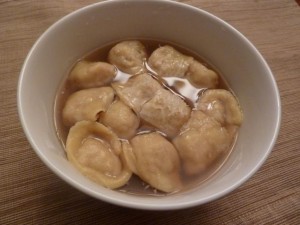
The Christmas season is upon us, and once again, Italian foodies here in the US are planning their Feast of the Seven Fishes for Christmas Eve. Italian restaurants are announcing their version of it for their December menu special, Saveur magazine features it in it’s December issue. Food bloggers cover it; I devoted two posts to it myself last year, here’s a link to Part I and Part II. It’s easy to find here in the US, but once place it’s hard to find it — Italy.
According to Wikipedia:
“is believed to have originated in Southern Italy and is not a known tradition in many parts of Italy”
According to Saveur:
“Started in America and sometimes called La Vigilia”
Waverley Root, in his classic tome “The Food of Italy” mentions over 30 different traditional regional Christmas dishes, and does not mention this Feast at all.
My Italiaoutdoors partner, Vernon, has been living in Vicenza, Italy for 20 years, and has never heard of it.
So I thought this season I’d research and make a few of the truly authentic regional Christmas dishes of Northern Italy.
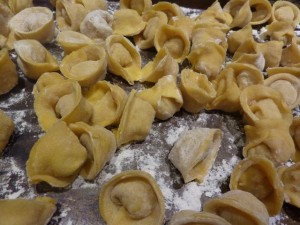
In my search through Waverley Root’s “The Food of Italy”, I found this great quote, which he attributes to the Gazzetta di Bologna, about 100 years ago: “Christmas should be celebrated in Christian fashion, that is to say by eating until you burst, drinking until your head spins, and in general loading down the human machine with choice wines and edible of all sorts, varieties and origins. But precede everything with a great dish of tortellini. Without tortellini there can be no Christmas in Bologna.” So tortellini makes my list of traditional Italian Christmas foods.
To the Bolognese, the shape of tortellini was inspired by the female navel. One story, hailing from the 17th century, claims that tortellini was created by a cook who molded the pasta in the navel of a Bolognese woman. In 1925, the play “The Man Who Invented Tortellini” was shown at Teatro del Corso in Bologna, in which a cook who is smitten with the young wife of his employer, makes a pasta dish inspired by the shape of her navel, and manages to have them served to her at a banquet.
I made my own tortellini, without the use of a navel, or even a pasta machine. Root mentions observing women making tortellini in a pasta shop, and that they produced about 6,000 tortellini an hour. I didn’t quite get up to that speed.
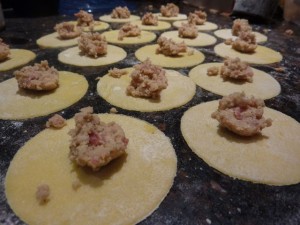
I referred to Lynne Rossetto Kasper’s book, “The Splendid Table”, a wonderful reference on the cuisine of Emilia-Romagna. Both Kasper and Root relate that the most traditional tortellini dish of the region are those that have been stuffed with a mixture of meats and parmigiano-reggiano cheese, and served simply in a beef broth. I based this recipe on the Pasta all’Uovo and Tortellini in Broth from “The Splendid Table.”
I only had duck eggs to use in this pasta, which made for a particularly luxurious end product. As duck eggs are significantly larger than chicken eggs, I assumed I would use less duck eggs than chicken, so I started with the amount of flour that Kasper
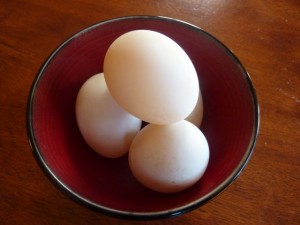
specifies, and used 3 duck eggs rather than the 4 chicken eggs. I was very surprised when I only used about 1/2 of the flour. The duck eggs are higher in protein and fat, and contain much less water than chicken eggs. The resulting pasta was very elastic, and easy to work with. This was very helpful, as I discovered when I went to roll out my pasta into sheets that both my mixer pasta attachment as well as my manual machine are back in Massachusetts. So I was forced to be truly traditional, and resort to a rolling pin.
Pasta all’Uovo d’Anatra
2 cups all-purpose unbleached flour
3 duck egg
1 beaten egg (of any type) for egg wash
Place the flour on your counter in a mound. Make a well in the middle. Add the eggs. Using a fork, lightly beat the eggs. Gradually start incorporating the flour from the sides of the well. Eventually the sides of the well will collapse, at this point use a pastry scraper to work the rest of the flour into the dough.
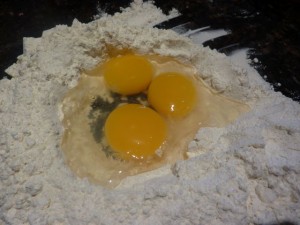
Knead the dough for about 10 minutes, working a bit more flour into it when it gets a bit sticky. The dough should be very smooth, silky, and very elastic. Take a sharp knife and cut the dough in half; if any air bubbles are visible in the dough, continue to knead it for another minute or so.
If using a rolling pin, divide the dough into quarters, and roll out one quarter at a time, keeping the remainder covered with plastic wrap so it does not dry out. The goal is to stretch the dough, rather than flatten it. When you are finished rolling, the sheet should be so thin that you can see through it. Taking a 1 3/4 inch cutter, or a small glass, cut the sheet into circles. Place approximately 1/2 teaspoon of filling in the center of each circle, and brush a little of the beaten egg around the outer edge of half of the circle. Fold the circle in half, and pinch the edges closed. Then take the corners on the bottom of the semi-circle, and pinch them together. Place the tortellini on a floured sheet pan when completed.
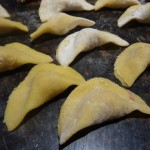
Tortellini Alla Bolognese
2 tablespoons unsalted butter
3 ounces ground pork
3 ounces ground chicken
1 strip bacon, diced
2 ounces salami
1/4 cup grated Parmigiano-Reggiano cheese
Pinch of nutmeg
1 egg, beaten
Melt the butter in a saute pan over medium-high heat. Add the pork, turkey and bacon, and saute until cooked through, breaking up the meat with a fork or a potato masher.
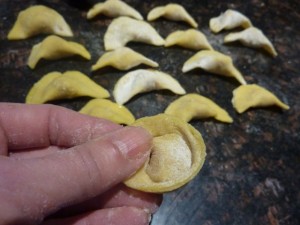
Transfer the meat to a food processor, and add the salami. Pulse until finely ground, but not pureed. Transfer to a bowl and add the cheese, nutmeg and egg. Season with salt and pepper.
To serve:
1 quart meat or chicken stock
Kosher salt and freshly ground pepper
Grated Parmegiano-Reggiano cheese
Heat the meat stock in a large saucepan and bring to a boil. Season with salt and pepper. Drop in the tortellini and cook a minute or two. Check one for doneness by tasting. They should be tender, but still have some ‘bite’, al dente. When done, ladle into small bowls and serve with grated Parmigiano-Reggiano cheese on the side.
